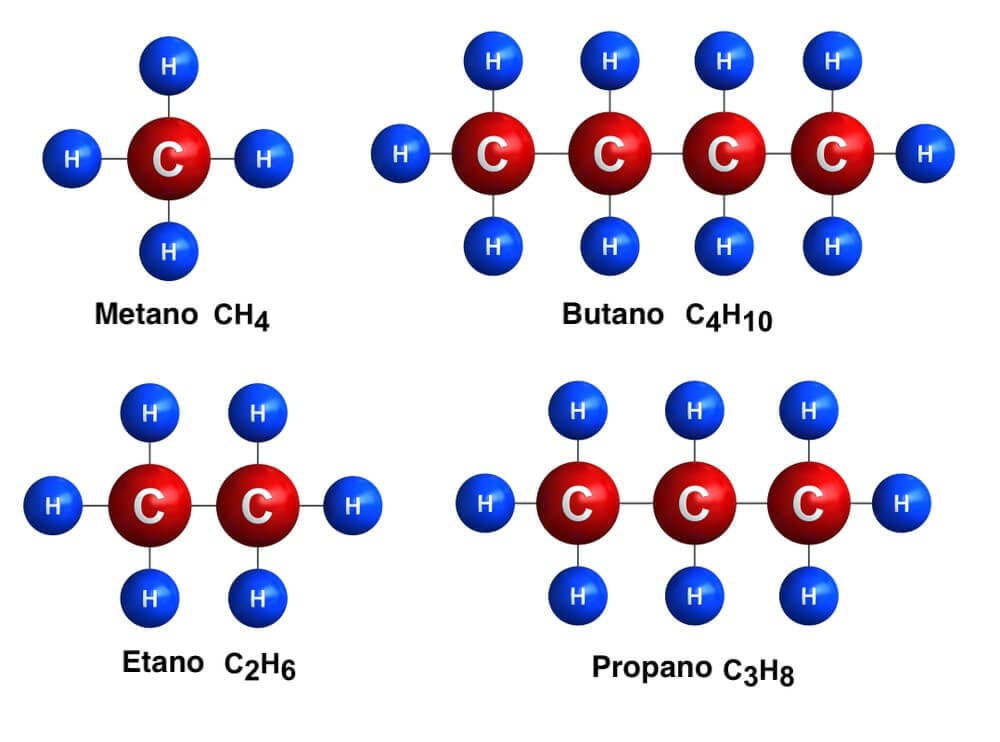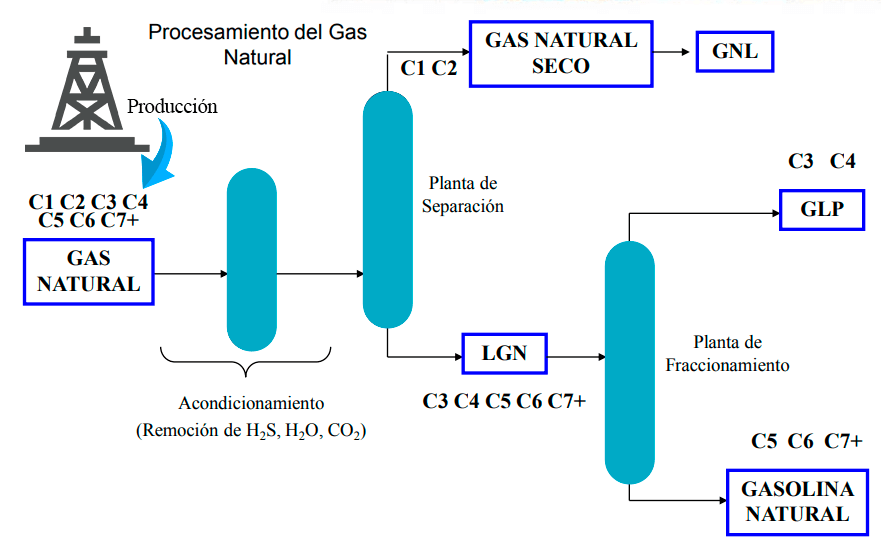Introduction
Natural gas is a fossil energy source that, like coal or oil, is made up of a mixture of hydrocarbons formed thanks to the decomposition of organic matter over millions of years. It is a non-toxic, colorless and odorless compound, made up of a mixture of hydrocarbons in which its main component is methane (CH4), a simple molecule made up of 1 carbon atom and 4 hydrogen atoms.
Its chemical composition, however, varies significantly depending on its origin, since it is usually associated with other molecules or elements such as hydrogen sulfide (H2S), carbon dioxide (CO2), nitrogen (N2) or helium (He) that must be extracted when natural gas is destined for industrial and domestic uses.
The origin of natural gas, like oil, is found in the decomposition processes of organic matter that took place between 240 and 70 million years, during the Mesozoic Era, when large reptiles and dinosaurs inhabited the planet. This organic matter came from planktonic organisms that accumulated on the seabed of coastal platforms or in the shallow basins of lakes, and which were buried under successive layers of earth by the action of natural phenomena.
Thus, its fundamental compounds –fats and proteins– were broken down very slowly in the absence of oxygen by bacterial action. The gases generated, due to pressure differences, ascended through the porous rocks of the earth’s crust until they reached layers of impermeable terrain under which they were retained, originating large pockets or deposits.
In nature, methane gas is produced as the end product of the anaerobic putrefaction of plants. This natural process can be exploited to produce biogas.
In a reservoir, the less heavy gas occupies the upper part of the cavity, the oil the intermediate part, and the lower part is usually salty water, which is why it is believed that it originated from the seabed. At high pressures, the gas mixes with oil –associated natural gas– or dissolves, but we can also find it alone, in bags other than those of oil.
This article will explain what natural gas is, its composition and its processing.
What is the natural gas?
Natural gas is a mixture of gaseous hydrocarbons that is frequently found in fossil deposits, non-associated (alone), dissolved or associated (accompanying oil) or in coal deposits. It is one of the most exploited fuels in the world, extracted from the subsoil in similar deposits (and sometimes even in the same place) as oil tankers.
Its origin is geological, like oil: diverse organic matter of vegetable and animal origin that was trapped for millions of years in the subsoil, subjected to conditions of intense heat and pressure. Thus, the chemical energy contained in matter is transferred to the gas, making it highly energetic.
Its discovery dates from 6,000 to 2,000 years before our era, in the territory of what is now Iran, and in the Baku region of what is now Azerbaijan. In fact, the first natural gas leaks, possibly ignited by accidental lightning, gave rise to the “eternal fires” worshiped by ancient Persian religions.
However, it was in ancestral China where the first extraction well for this resource was dug, about 150 meters deep; a titanic task carried out with bamboo tools and primitive drills around 211 B.C. c.
Natural gas is a fossil fuel and therefore is a non-renewable natural resource of our planet.
Composition of natural gas
Natural gas is a mixture of hydrocarbons. It is composed mainly of methane (CH4) and ethane (C2H6), although it can also contain amounts of light gases such as butane (C4H10) and propane (C3H8), especially when it is diluted with oil (that is, in the same reservoir, the called “associated natural gas”), (figure 1).
In addition, it may contain traces of other compounds and elements, such as carbon dioxide, nitrogen, hydrogen sulfide or helium.

Natural gas has a composition similar to that of biogas, generated by the anaerobic digestion of organic matter by microorganisms. However, it is much more powerful than this one.
Natural gas processing
It is a complex industrial process designed to separate impurities and various non-methane hydrocarbons and fluids in order to produce what is known as natural gas.
Natural gas is generally made up primarily of methane (CH4), the smallest and lightest hydrocarbon molecule. It also contains variable amounts of heavier hydrocarbon gases, acid gases, and other gases such as: nitrogen and helium, water, liquid hydrocarbons, and in some cases, mercury.
The current practice of processing natural gas to quality standards for pipeline transportation can be quite complex, but generally involves four main processes to remove various impurities:
- Oil and condensate removal
- water removal
- Separation of natural gas liquids
- Sulfur and carbon dioxide removal
In a very general and non-standardized way, it can be said that natural gas and its condensates can be subjected to various types of processing, which can be divided according to:
Conditioning processes: These are various physicochemical processes that allow the elimination of the different impurities contained in the gas, just as it comes out of the production wells, and which are made up of compounds such as sulfur, water, CO2 and others that have no commercial value.
Separation processes: These are physicochemical processes that allow natural gas to be separated into a fraction that is in the gas phase, usually called Dry Gas, which is subsequently sent by gas pipelines to final consumers or to new processing plants depending on the final use of natural gas. A liquid fraction is also obtained at process conditions called Natural Gas Liquids (NGL) or Condensates, which are later sent through Pipelines or ships to other Plants for subsequent fractionation.
Fractionation processes. – They are physicochemical processes that allow the separation of the various components of Natural Gas Liquids such as ethane, propane, butane, natural gasoline and Medium Distillate for Blending Stock (MDBS) for subsequent shipment as fuel to final consumers or shipment as fuel. raw material for gasoline blending plants or petrochemical plants. Figure 2 shows a general outline of natural gas processing.

Uses and benefits
The uses of this fossil energy are multiple, first of all, for domestic use, this fossil energy reaches homes through gas pipelines, which are pipes that are connected between producer and consumer countries.
Natural gas is also demanded by industries and large businesses due to the advantages it has and its little negative impact on the environment. Large companies generally use it in production machines that use heat to assemble parts or shape them. On the other hand, power plants are capable of generating electricity with this fuel, in addition, with a much higher energy efficiency than other conventional power plants (57% more). As the fuel that it is, it is also used in vehicles due to the advantages it has. It is estimated that there are 20 million forms of transport that use it, but those for public use stand out above all, such as urban buses, taxis or boats.
Among the most outstanding advantages of this fossil energy, first of all, it should be noted that natural gas has a high calorific value, reaching 10.67kWh/NM3 on average. On the other hand, it is easy to access, since it is a supply that reaches homes or industrial buildings constantly.
Another important aspect to highlight is its low cost compared to other fossil fuels, also, although the price varies depending on the price of oil, the variation is not exaggerated, thus leaving a constant average price. Its versatility is also remarkable, since it can be used in a multitude of different devices: heating devices, industrial machines, even to generate cold in refrigeration installations.
On the other hand, one of its greatest advantages is that it is the fuel that pollutes the least, therefore, it manages to preserve the environment. In addition, it is more energy efficient, so less is needed to achieve the same results as another hydrocarbon. Finally, it should be noted that it is a safe fuel, thanks to the volatility of its particles, which do not remain impregnated in the environment, there is no danger from inhalation or explosion.
References
- Rondon, E. (2005). Natural gas technology. Opica Consultants CA,
March, 2005. - https://concepto.de/gas-natural/#ixzz7kdxWXKwq

